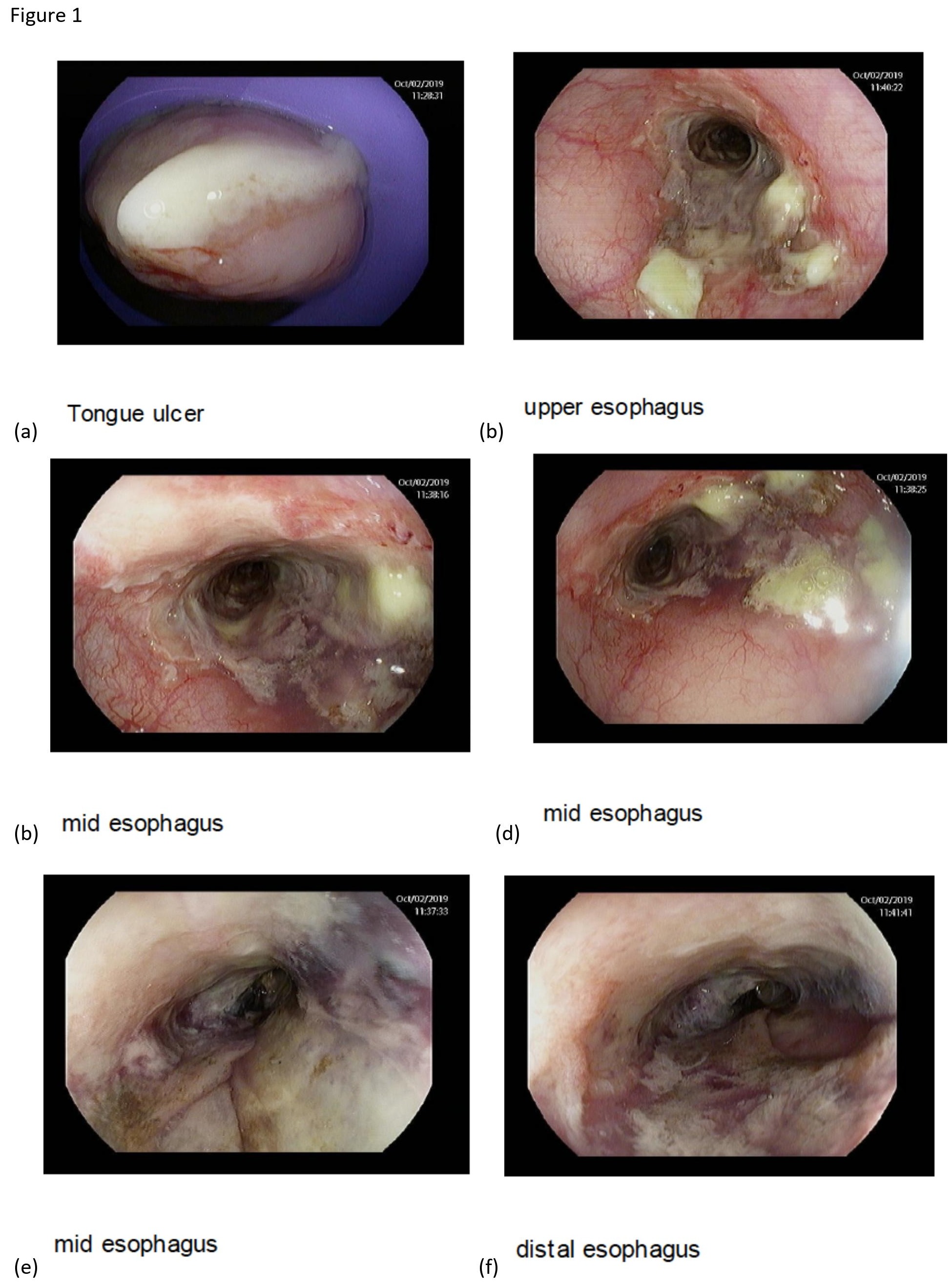Back
Poster Session E - Tuesday Afternoon
E0214 - Esophageal Manifestations of Paraneoplastic Pemphigus Vulgaris Associated With Gastric Neuroendocrine Tumor
Tuesday, October 25, 2022
3:00 PM – 5:00 PM ET
Location: Crown Ballroom

Tanmay Gaglani, MD
The University of Texas Health Science Center at Houston
Houston, TX
Presenting Author(s)
Tanmay Gaglani, MD1, Keith Garrison, MD2, Brooks D. Cash, MD, FACG3
1The University of Texas Health Science Center at Houston, Houston, TX; 2University of Texas Houston Health Sciences Center, Houston, TX; 3University of Texas Health Science Center, Houston, TX
Introduction: While pemphigus vulgaris (PV) typically affects the epidermis and oral mucosa, esophageal manifestations are uncommon. The primary symptoms accompanying this manifestation are dysphagia, odynophagia, and hematemesis. In this case report we examine the occurrence of esophageal pemphigus vulgaris associated with a gastric neuroendocrine tumor and note the endoscopic findings of esophagitis dessicans superficialis (EDS) within the esophagus.
Case Description/Methods: A 63-year-old female with a history of P-ANCA vasculitis presented for evaluation of dyspnea, hypotension, fatigue, rash, and dysphagia. The patient was thought to have an infectious cause of these signs and symptoms, however given a lack of response to antibiotic and antifungal therapy within 48 hours the differential was broadened to include rheumatologic disease. The patient was treated with intravenous methylprednisolone and continued to experience dysphagia.
Esophagogastroduodenoscopy was performed [Fig.1] and demonstrated a tongue ulceration and extensive desquamation in the distal esophagus appearing similar to a pseudomembrane. Extensive subepithelial hemorrhages were observed in the esophagus, however the gastric and duodenal mucosa were intact. Esophageal and gastric biopsies demonstrated staining for IgG reactive to desmoglein 3 consistent with PV. In addition, a well-differentiated neuroendocrine tumor (NET) in the stomach.
The patient was subsequently treated with octreotide for her neuroendocrine tumor, as well as solumedrol and dapsone for her skin lesions. She also received a loading dose of rituximab. She received a second dose of rituximab 21 days after the loading dose and the corticosteroids were tapered as her symptoms of dysphagia gradually improved with immunosuppressive therapy.
Discussion: Esophagitis dessicans superficialis has been described as sloughing of the superficial esophageal mucosa and is similar in appearance to the Nikolsky sign of external squamous epithelium seen with immunobullous diseases. Our patient presented with undiagnosed PV and had both esophageal and skin involvement with the concomitant gastric NET. The ultimate diagnosis of PV was confirmed based on the presence of antibodies to desmoglein 3 and it remains unknown if the gastric NET had any role in the development of PV. Clinicians should have a low threshold for endoscopic examination of patients for whom there is suspicion of immunobullous disease to facilitate rapid diagnosis and initiation of appropriate therapy.

Disclosures:
Tanmay Gaglani, MD1, Keith Garrison, MD2, Brooks D. Cash, MD, FACG3. E0214 - Esophageal Manifestations of Paraneoplastic Pemphigus Vulgaris Associated With Gastric Neuroendocrine Tumor, ACG 2022 Annual Scientific Meeting Abstracts. Charlotte, NC: American College of Gastroenterology.
1The University of Texas Health Science Center at Houston, Houston, TX; 2University of Texas Houston Health Sciences Center, Houston, TX; 3University of Texas Health Science Center, Houston, TX
Introduction: While pemphigus vulgaris (PV) typically affects the epidermis and oral mucosa, esophageal manifestations are uncommon. The primary symptoms accompanying this manifestation are dysphagia, odynophagia, and hematemesis. In this case report we examine the occurrence of esophageal pemphigus vulgaris associated with a gastric neuroendocrine tumor and note the endoscopic findings of esophagitis dessicans superficialis (EDS) within the esophagus.
Case Description/Methods: A 63-year-old female with a history of P-ANCA vasculitis presented for evaluation of dyspnea, hypotension, fatigue, rash, and dysphagia. The patient was thought to have an infectious cause of these signs and symptoms, however given a lack of response to antibiotic and antifungal therapy within 48 hours the differential was broadened to include rheumatologic disease. The patient was treated with intravenous methylprednisolone and continued to experience dysphagia.
Esophagogastroduodenoscopy was performed [Fig.1] and demonstrated a tongue ulceration and extensive desquamation in the distal esophagus appearing similar to a pseudomembrane. Extensive subepithelial hemorrhages were observed in the esophagus, however the gastric and duodenal mucosa were intact. Esophageal and gastric biopsies demonstrated staining for IgG reactive to desmoglein 3 consistent with PV. In addition, a well-differentiated neuroendocrine tumor (NET) in the stomach.
The patient was subsequently treated with octreotide for her neuroendocrine tumor, as well as solumedrol and dapsone for her skin lesions. She also received a loading dose of rituximab. She received a second dose of rituximab 21 days after the loading dose and the corticosteroids were tapered as her symptoms of dysphagia gradually improved with immunosuppressive therapy.
Discussion: Esophagitis dessicans superficialis has been described as sloughing of the superficial esophageal mucosa and is similar in appearance to the Nikolsky sign of external squamous epithelium seen with immunobullous diseases. Our patient presented with undiagnosed PV and had both esophageal and skin involvement with the concomitant gastric NET. The ultimate diagnosis of PV was confirmed based on the presence of antibodies to desmoglein 3 and it remains unknown if the gastric NET had any role in the development of PV. Clinicians should have a low threshold for endoscopic examination of patients for whom there is suspicion of immunobullous disease to facilitate rapid diagnosis and initiation of appropriate therapy.

Figure: Figure 1: Endoscopic images demonstrating tongue ulceration and extensive desquamation in the distal esophagus appearing similar to a pseudomembrane in addition to subepithelial hemorrhages.
Disclosures:
Tanmay Gaglani indicated no relevant financial relationships.
Keith Garrison indicated no relevant financial relationships.
Brooks Cash: AbbVie – Consultant, Speakers Bureau. Ardelyx – Consultant, Speakers Bureau. Motus – Consultant. QOL – Consultant, Speakers Bureau. RedHill – Consultant, Speakers Bureau. Salix – Consultant, Speakers Bureau. Takeda Pharmaceuticals – Consultant.
Tanmay Gaglani, MD1, Keith Garrison, MD2, Brooks D. Cash, MD, FACG3. E0214 - Esophageal Manifestations of Paraneoplastic Pemphigus Vulgaris Associated With Gastric Neuroendocrine Tumor, ACG 2022 Annual Scientific Meeting Abstracts. Charlotte, NC: American College of Gastroenterology.
